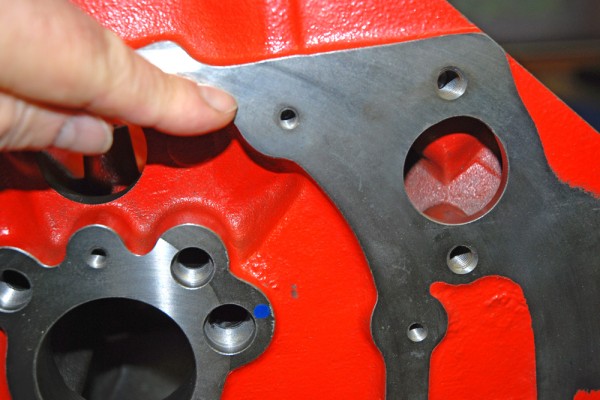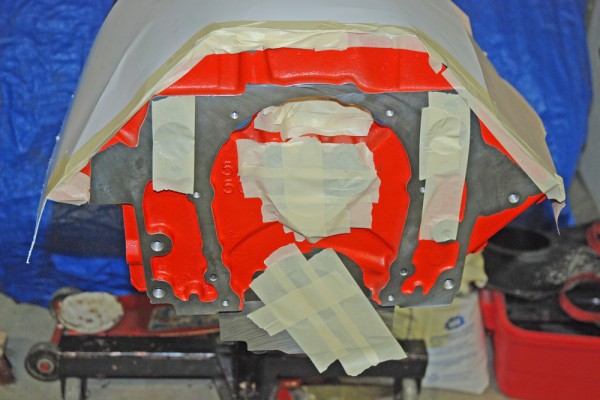Let’s assume you bought a brand spanking new block and it’s back from the machine shop. It’s machined and it’s ready to go. Or is it?
Probably not.
You need to prep it for assembly. That involves cleaning the block and installing the various hardware pieces (galley plugs, oil filter adapter(s), cooler lines and so on). Another issue is the fit of various components used in or on the engine–they’ll likely require a test fit.
Test fitting is critical because some parts might require a bit of massaging to fit, and you should do this before the block (and the various parts) are cleaned. Case-in-point is the Jesel belt drive we installed on a Gen VI Chevy bow tie block. After the belt drive cover was designed, engineered, and built by Jesel, the block manufacturer made a change to its engine block. That resulted in component interference. In our situation, there were two points of interference (see the accompanying photos).
In order to correct the interference issues, we taped off the block first. The block will be fully cleaned a bit later; however, the tape is used to make the final clean up a little easier. We carefully ground down the offending casting “lumps” within the cylinder block timing chain cover valley. A die grinder works perfectly, and it’s just a matter of grinding a bit, test fitting the cover, and so on until it all fits.
With test-fitting out of the way, the actual cleaning process is next. Contamination in a fresh engine is a sure cause of grief. Any piece of grit that turns up during the assembly process can (and most definitely will) scratch internal surfaces such as the cylinder walls or reciprocating components. “Metal pollution” is likely one of the leading causes of early engine failure. Even if your machine shop cleans the parts, they should still be thoroughly re-cleaned and kept clean before and during the engine assembly job.
So how do you clean it?
Scrub everything with hot water and good old-fashioned liquid dish detergent (car wash detergent works too). Before you even start the cleaning process, keep this in mind: Once you start cleaning the block with soap and water, you can’t stop until the job is done. There’s a saying about “rust never sleeping,” and it applies here. That means you need to set aside time to complete both the wash and dry cycles.
To scrub our engine block, we mix hot water and soap in a bucket. We also use a pressure washer connected to a hot water tap. You’ll need to access all of the oil gallery holes, so the block gallery plugs should all be removed (as is regularly the case with blocks that have been through a machining process). Summit Racing offers several different brush kits for prepping engine blocks, and we used a 9-piece Mr. Gasket brush kit designed to work in all engine oil galleries. Also included is a pair of extra-long brushes for scrubbing oil galleries next to the cylinder block lifter bores.
We use a conventional car wash scrub brush for the initial cleaning. Once that’s done, we remove the cylinder block main caps and go through all of the oil galleries with the brush kit. Once you figure everything is clean, start all over again and rescrub the entire works.
Honestly, you can’t get it too clean.
Once the second wash cycle is complete, turn on the hot water (pressure washer or a hose connected to a hot water supply). Every nook, cranny and oil gallery should be blown out with clean hot water. We continue the hot rinse water until the water comes out clean. At that point, flip the block over and continue the hot water rinse. We’d suggest you repeat the complete process at least once more before drying it off.
A big air compressor is the best choice for drying off the block. No matter what type of compressor you own (or rent), set the regulator to provide air in the range of 100-plus psi. Snap a blowgun attachment into the air hose and basically, let the compressor rip. Blow as much water off the engine as possible (the quicker the better). Don’t be afraid to use the air power to clean all of the water from the oil galleries.
Once the cylinder block is air-dried, you absolutely, positively must oil all of the machined surfaces. There are a couple of ways to accomplish this: A clean lint-free shop rag or lint-free paper towel soaked in clean light oil (for example 10-30) or automatic transmission fluid works. Ditto with a light mist of WD40, followed by a wipe down with clean lint-free shop towel. As an added benefit, WD40 will naturally displace water. We make it a practice to clean the machined surfaces until the towels show absolutely no trace of dirt. We recommend the mechanic-style shop towels, since they don’t tear or shed as easily as kitchen towels (Summit Racing sells these in individual rolls).
Smaller parts such as main caps can be stored and sealed in fresh plastic bags (freezer bags work) until they’re required for assembly. When cleaning items such as a crankshaft, you’ll note that the small brushes in the brush kit go a long way toward getting into the various oil passages. It should be apparent, but be careful to not nick any machined surfaces.
We’re not quite done yet.
All engine blocks are equipped or designed to accept a series of pipe plugs in the various galleries. They’ve most likely been removed during the machining and hot tanking process (or they might not have been installed on a fresh new block). They shouldn’t be present during your clean up, and you’ll need to replace them before assembly. Depending upon the block, Summit Racing has you covered with kits from Sealed Power, Dorman, and others. In some cases, AN (aluminum) plugs with internal hexes can be used (you’ll have to specify the correct thread for the application), and in other spots brass plugs are used.
For some applications, a rear cam plug will have to be installed, too. Most of these are of the drive-in (with a hammer) variety. It’s best to leave the cam plug out until later (after the camshaft has been installed). Keep in mind that for some engines, the layout of the engine stand doesn’t allow good access to the back of the block, so you won’t be able to install the plug until the engine is off the stand. Just don’t forget to install the plug!
Aside from the brass soft plugs, the remainder of the plugs found on a cylinder block are pipe thread. That means the plug is tapered and it will need either PTFE tape (a pain) or Pipe Thread Sealant. Summit Racing sells it in various forms, including a pretty cool stick format. You simply coat the threads with sealant and install the plugs.
Finally, you’ll need to install the oil filter bypass valve along with the oil filter adapter. Given the block and the manufacturer, there are plenty of different formats out there, but for our Gen VI big block, the bypass valve simply drops into the block. It’s driven home and set with a hammer and a small socket. The oil filter adapter is a double-threaded job. The block side should have the threads lightly covered in Blue medium strength Threadlocker (it’s not a good idea to use Red, as it will require considerable heat if the adapter requires removal). Make sure to torque it down to spec.
At this point, you can wrap up the engine block to protect it from dirt. While jumbo garbage bags can work, they’re simply too flimsy. Real engine storage bag are preferred. Summit Racing stocks heavy 4-mil plastic bags from Moroso. These are specially designed to protect engines against dirt and moisture. They’re sufficiently large to accommodate an assembled big-block, even one with headers in place. By the way, it’s a good idea to wrap the block or engine immediately after the work has ended.
Check out the photos above for more.


















It is great that you post this! I’ll now get down to business! Thanks! Greets, Monken Hadley Carpet Cleaners Ltd.
In a pinch, heavy duty contractors garbage bags (black) will suffice!
Just did a rebuild on vi 7.4L 454.
I have no oil ti the rocker arms. (New lifters and roller rockers adjustable).
Checked front three plugs. There installed.
On startup oil pressures 80 PSI. After three minuts or so it drops to 40 PSI. Can’t figure it out.
Too much clearance in the rod bearings and mains
Just did a rebuild on a VI 7.4L 454.
I have no oil to the rocker arms. Installed new compcam lifters push rods and roller rockers (adjustable).
Checked the three plugs in fromt of engine. All three are installed.
Note: on startup oil pressures jump to 80 PSI after 3-4 minutes drops to 40 PSI.
Cant figure it out.
I’m sure by now you have corrected the problem, but I wanted to share that i recently had the same issue and it ended up being the lifters.
oil warmed up , so its thinner, hence a drop in pressure as opposed to cold oil which is thicker
Thank guys. Car maintenance shouldn’t just be as superficial as keeping your car looking clean and good on the surface. You also have to clean its internal engine parts to prevent the buildup of sludge, grease, dirt, rust, etc.
The rear cam bearing is not clocked right, it’s not allowing the oil from the rear main to get to the lifter galley